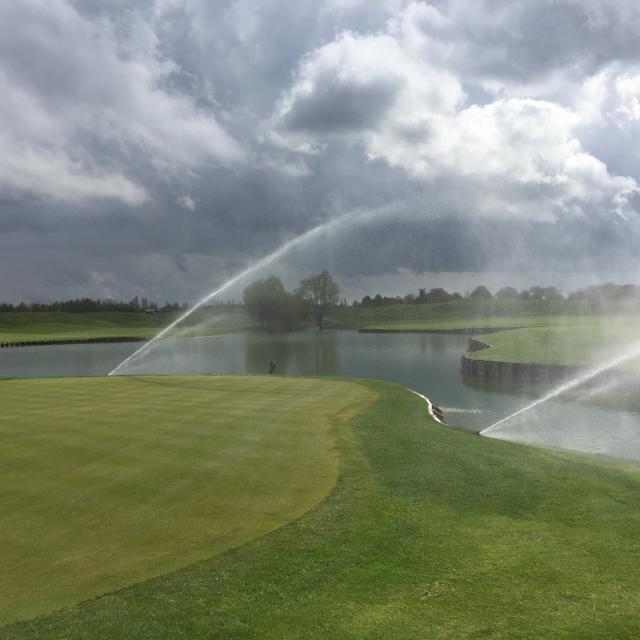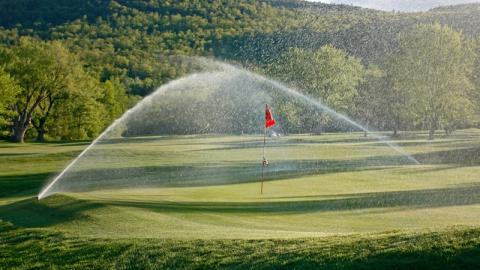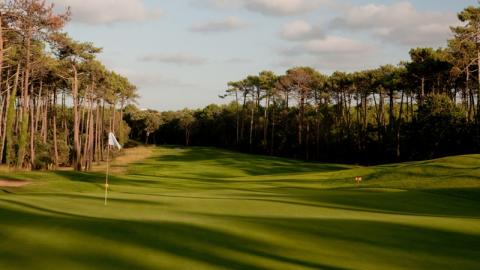With 720 member golf clubs representing 33,000 hectares of natural spaces, the foremost concern of the FF of Golf (ffgolf) is the conservation of the environment and preserving water. Some feedback on the ten years of activities and the results obtained.

Conscious of the image that our sport may have in general, from an environmental point of view, and more specifically with regard to water consumption, over the last ten years the ffgolf has been working on the transparency of the practices used for the management and maintenance of the golf courses in France and continues its efforts to achieve optimised water management.
TRUE OR FALSE?
All the playing surfaces of a golf course are irrigated
FALSE. If an 18-hole golf course covers around 50 hectares of land, only 25% is likely to be irrigated, involving primarily the greens and the tees, which in themselves only represent 2 hectares. The remaining part consists of natural unspoilt natural areas, where the biodiversity can develop freely.
The golf clubs are reducing their water consumption
TRUE. The golf clubs have undertaken considerable effort. Overall, the water consumption of all the golf clubs has fallen by 14% at in 5 years. Increasing investment made by the golf clubs in better technologies and research into new solutions should help to ensure that this positive trend continues.
Not all golf courses are heavy consumers of water
TRUE. Almost 70% of golf clubs consume less than the national average measured at 25,000 m3 per 9-hole section. For the largest consumers, the water used comes from the canals or even the purification plants. These two water sources do not suffer from conflicts over their usage.
The golf courses consume as much water as several thousand residents
FALSE. Only 10% of golf clubs use water from the public mains (drinking water) system. The cost of public (mains) water is a considerable expense for golf clubs that are forced to use it, so they are careful to make the very best use of the resource and keep control over their finances. A study revealed that their consumption of public water dropped 20% in 5 years. A 9-hole golf course consumes, on average, the same amount of water as that consumed by a municipality of 350 inhabitants.
Golf courses pollute and destroy the environment
FALSE. Many golf course, through their architectural design and location, enhance the environment. Their wetlands and natural areas help to ensure that there is an urban environment with ecological continuity and they contribute towards having better air quality. The development of their biodiversity tends to prove that these sites are managed soundly and that the professionals responsible for them have not been idle.
TEN YEARS OF FEDERAL COMMITMENT
In 2004, the ffgolf set up a statutory committee to address issues relating to the conservation of the environment, sustainable development and making the clubs and players aware of these topics.
In 2006, the first water charter was signed by the ffgolf, the associations representing the golf industry and the Ministers of Sport and the environment, committing the sector to reduce water consumption, prioritising golf clubs that use water from the public mains systems (drinking water). The charter guarantees, unless there should be a shortage of drinking water, the survival of our courses, above all during a period of extreme drought. On the other hand, the ffgolf and the golf course managers undertake to research and implement all possibilities of reducing and finding alternatives for irrigation. This will give us a true appreciation of the economic and ecological role played by our sport.
In 2010, the parties decided to persist with the consultation, to build on it and involve the Ministry of Agriculture and Fisheries, bearing in mind the work currently being undertaken into the qualitative aspect of water management and the Ecophyto 2018 plan. The new national “Golf and the Environment” charter was signed.
In March 2013, the president Georges Barbaret presented Mrs Valérie Fourneyron, Minister of Sport, Youth, Popular Education and Community Life, with the 1st 5-year report of the National Golf and the Environment Charter relating to the conservation of the water resource. This document has demonstrated the efforts made by the sector, since the first charter, to reduce water consumption.
THE RESULTS
The water used for irrigation by 90% of the golf clubs is unfit for human consumption (surface water. groundwater, rainwater, water used and treated by purification plants, agricultural wastewater…). Only 10% of the golf courses have access to potable (drinking) water.
- There was a 20% reduction in the consumption of water from the public mains systems, calculated between 2006 and 2010. This downward trend should continue, mainly because of new and more effective management tools.
- There was, on average, a 14% reduction over the last 5 years in the overall consumption of water by golf courses.
PRECONCEIVED NOTIONS THAT NEED TO BE DISMISSED
A golf course should evolve naturally throughout the seasons, just like the sporting challenge that it offers. Irrigation should be rationalised, at the cost of having a turf that appears to be scorched in the summer. However, even though this visual aspect could cause a surprise, it does not adversely affect the attraction of the course in sporting terms. Such a philosophy could lead to substantial savings on water. The ffgolf and the golfing sector should make the players more aware of the part they can play in generally recognising what a natural golf course really represents.


